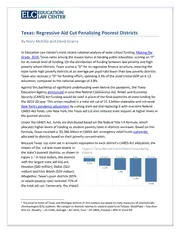
ERIC ED609041: Texas: Regressive Aid Cut Penalizing Poorest Districts PDF
Preview ERIC ED609041: Texas: Regressive Aid Cut Penalizing Poorest Districts
Texas: Regressive Aid Cut Penalizing Poorest Districts By Mary McKillip and David Sciarra In Education Law Center’s most recent national analysis of state school funding, Making the Grade 2019, Texas ranks among the lowest states in funding public education, scoring an “F” for its overall level of funding. On the distribution of funding between low-poverty and high- poverty school districts, Texas scores a “D” for its regressive finance structure, meaning the state funds high-poverty districts at an average per pupil rate lower than low-poverty districts. Texas also receives a “D” for funding effort, spending 3.3% of the state’s total GDP on K-12 education, compared to the national average of 3.8%. Against this backdrop of significant underfunding even before the pandemic, the Texas Education Agency announced in June that federal Coronavirus Aid, Relief, and Economic Security (CARES) Act funding would be used in place of the final payments of state funding for the 2019-20 year. This action resulted in a total aid cut of $1.3 billion statewide and mirrored New York's pandemic adjustment by cutting state aid and replacing it with one-time federal CARES Act funds. Like New York, the Texas aid cut also reduced state support at higher levels in the poorest districts. Under the CARES Act, funds are distributed based on the federal Title I-A formula, which allocates higher levels of funding as student poverty rates in districts increases. Based on this formula, Texas received a $1.286 billion in CARES Act emergency relief funds statewide, allocated to districts based on their poverty concentration. Because Texas cut state aid in amounts equivalent to each district’s CARES Act allocation, the impact of the cut was most severe in the state’s poorest districts, as shown in Figure 1.1 In total dollars, the districts with the largest state aid loss are Houston ($82 million), Dallas ($62 million) and Fort Worth ($29 million). Altogether, Texas’s poor districts (65% or above poverty rate) received 71% of the total aid cut. Conversely, the impact 1 The poverty levels of Texas and Michigan districts in this analysis are based on state measures of economically disadvantaged (ED) students. We categorize districts relative to student poverty as follows: Wealthiest – less than 35% ED, Wealthy – 35-<50%, Average – 50-<65%, Poor – 65-<80%, Poorest – 80% or more ED. 2 on wealthier districts was minimal. For example, while Houston was hit with a 4.3% state aid cut, neighboring Katy’s was only 0.7%. Figure 2 shows the per-pupil cut in state aid under Texas’s “pandemic adjustment” for 2019-20. If Texas had not used the federal CARES funding to replace state aid, the poorest districts would have received their full state aid appropriation for 2019-20 along with an additional $367 per-pupil in CARES Act funds to respond to COVID-19 impacts. Instead, Texas’s poorest districts had their state aid cut by $367 per-pupil on average, the equivalent amount of CARES Act federal emergency funds allocated to these districts. The state aid cut entirely wiped out the extra benefit intended by Congress in providing emergency relief: to enable districts to address additional needs in the current health crisis. Like New York, Texas’s wealthiest districts lost only $48 per-pupil in state aid, in line with their allocation of CARES Act relief funds. Finally, Figure 3 shows the disproportionate impact of Texas’s state aid cut on the state’s nine majority Black districts and 317 majority Latino districts. These districts were cut an average of $258 per-pupil and $291 per-pupil in state aid, respectively. District-level details for Texas are available here Texas has followed the playbook from the Great Recession, also used by New York, in responding to the pandemic. The state cut aid then backfilled the budget hole with non- recurring federal emergency funds. These cuts are disproportionately higher in districts segregated by poverty, those most in need from COVID-19. By cutting state aid, Texas has deprived the state’s most vulnerable students of the funds necessary to tackle the digital divide and prepare their schools to safely reopen. Mary McKillip is a Senior Researcher at Education Law Center and David Sciarra is Executive Director of ELC.
